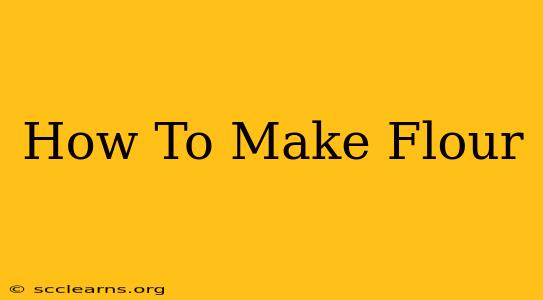Making your own flour is a rewarding experience, connecting you directly to the source of your food and allowing for greater control over quality and ingredients. Whether you're aiming for a specific texture, want to experiment with different grains, or simply enjoy the process, this guide will walk you through the steps of making flour at home.
Understanding the Flour-Making Process
Before we begin, let's clarify what making flour entails. It's essentially a process of breaking down grains – such as wheat, barley, rye, or corn – into a fine powder. This involves several key steps:
1. Grain Selection and Cleaning:
- Choosing your grain: The type of grain dictates the flavor and properties of your flour. Wheat is the most common, offering various protein contents resulting in different flours (e.g., bread flour, all-purpose flour, cake flour). Other grains like rye, barley, and corn produce unique flour types.
- Cleaning the grain: Remove any debris, stones, or unwanted materials by gently sifting or winnowing the grain. This ensures a cleaner, purer final product.
2. Grain Milling:
This is the core of flour production. Several methods exist:
- Stone grinding: This traditional method uses a pair of stones to crush the grain, resulting in a flour with more pronounced flavors and nutrients (often referred to as "whole grain" flour).
- Using a Grain Mill (Electric or Manual): Electric grain mills are convenient and efficient for larger quantities. Manual mills are excellent for smaller batches and provide a more hands-on experience. Both options provide a range of grinding adjustments from coarse to fine.
- Using a Food Processor or Blender: For smaller quantities, a powerful food processor or high-speed blender can effectively grind grains into flour, although it might not achieve the same consistency as dedicated grain mills.
3. Sifting (Optional but Recommended):
Sifting removes larger particles and bran, resulting in a finer, smoother flour. This step is especially useful if you're aiming for a refined flour texture. However, keep in mind that sifting also removes some of the nutrients present in the bran.
Types of Flour You Can Make at Home
The type of flour you produce depends heavily on the grain and the fineness of the grind. You can create:
- Whole Wheat Flour: This flour includes the entire grain kernel – bran, germ, and endosperm – resulting in a nutritious flour with a coarser texture and nutty flavor.
- All-Purpose Flour: A blend typically mimicking commercially available all-purpose flour, often requiring a specific grain type and grind consistency.
- Bread Flour: Made from hard wheat with a high protein content, ideal for creating strong gluten structure in breads.
- Cake Flour: Made from soft wheat with low protein content, suitable for cakes and pastries that require a tender crumb.
- Rye Flour: Made from rye berries, offering a distinct flavor and darker color.
- Corn Flour (Cornmeal): Ground corn kernels, commonly used in cornbread and other dishes.
Tips for Making High-Quality Flour
- Start with high-quality grains: The quality of your flour directly correlates to the quality of your starting grain.
- Experiment with grind sizes: Adjust the grind setting on your mill to achieve your desired texture.
- Store flour properly: Store your homemade flour in an airtight container in a cool, dry place to maintain freshness and prevent pest infestations.
Beyond the Basics: Exploring Flour Creations
Once you master the basics, consider experimenting with different grain blends, adding spices or other ingredients, and exploring different milling techniques to create unique flour varieties tailored to your culinary needs.
Making your own flour is a journey of discovery, combining practicality with a deeper connection to your food. This process allows you to control the ingredients and quality while adding a unique touch to your baking and cooking. So, gather your grains and start your flour-making adventure!

